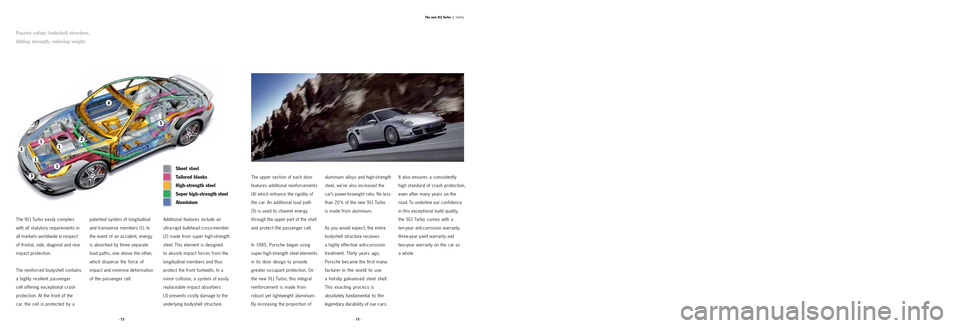Page 32 of 61

The 911 Turbo easily complies
with all statutory requirements in
all markets worldwide in respect
of frontal, side, diagonal and rear
impact protection.
The reinforced bodyshell contains
a highly resilient passenger
cell offering exceptional crash
protection. At the front of the
car, the cell is protected by apatented system of longitudinal
and transverse members (1). In
the event of an accident, energy
is absorbed by three separate
load paths, one above the other,
which disperse the force of
impact and minimise deformation
of the passenger cell.The upper section of each door
features additional reinforcements
(4) which enhance the rigidity of
the car. An additional load path
(5) is used to channel energy
through the upper part of the shell
and protect the passenger cell.
In 1985, Porsche began using
super high-strength steel elements
in its door design to provide
greater occupant protection. On
the new 911 Turbo, this integral
reinforcement is made from
robust yet lightweight aluminium.
By increasing the proportion ofaluminium alloys and high-strength
steel, we’ve also increased the
car’s power-to-weight ratio. No less
than 20 % of the new 911 Turbo
is made from aluminium.
As you would expect, the entire
bodyshell structure receives
a highly effective anti-corrosion
treatment. Thirty years ago,
Porsche became the first manu-
facturer in the world to use
a hot-dip galvanised steel shell.
This exacting proces s is
absolutely fundamental to the
legendary durability of our cars.It also
ensures a consistently
high standard of crash protection,
even after many years on the
road. To underline our confidence
in this exceptional build quality,
the 911 Turbo comes with a
ten-year anti-corrosion warranty,
three-year paint warranty and
two-year warranty on the car as
a whole.
· 72 ·· 73 ·The new 911 Turbo |
Safety
1
1
1
5
4
3
3
12
Sheet steel
Tailored blanks
High-strength steel
Super high-strength steel
Aluminium Passive safety: bodyshell structure.
Adding strength, reducing weight.
Additional features include an
ultra-rigid bulkhead cross-member
(2) made from super high-strength
steel. This element is designed
to absorb impact forces from the
longitudinal members and thus
protect the front footwells. In a
minor collision, a system of easily
replaceable impact absorbers
(3) prevents costly damage to the
underlying bodyshell structure.
Page 43 of 61

At Porsche, we’re exploring every
possibility to improve the environ-
mental compatibility of our cars:
modern materials, reduced fuel
consumption, cleaner emissions,
fewer pollutants and better
recyclability. This commitment is a
Porsche tradition that began in
the 1960s. With the latest evolutionof the 911 Turbo, the rewards are
even greater than ever.
Exhaust emission control.
Combine engineering expertise
with a commitment to the
environment and the resulting
benefits are twofold: exceptional
performance and lower emissions.
One of the cleanest sportscars
in the world today, the new
911 Turbo easily complies with
both the stringent Euro 4 standard
in the European Union as well
as LEV II regulations in the United
States.The technologies used to achieve
this compliance include twin
‘lambda’ or oxygen sensors for
each of the two cylinder banks.
One pair of sensors is used to
measure the levels of oxygen in
each of the twin exhaust tracts.
An additional pair of sensors –
again, one in each tract – enablethe engine management system
to monitor the efficiency of the
catalytic converters.*
Recycling.
Lightweight construction, long-
term durability, exceptional
recyclability: just three of the
techniques employed by Porsche
to improve the environmental
compatibility of our cars.
On the new 911 Turbo, we’ve
used weight-saving design and
lightweight materials to achieve
excellent fuel economy.
All materials and manufacturing
processes have been carefully
selected and specifically refined
to reduce any impact on the
environment. A prime example is
the twin exhaust system, which is
made entirely from stainless steel.
All lightweight materials are easily
recyclable, while the variety ofsynthetics has been significantly
reduced. Recycled plastics are
used in every area of the car
where our exacting specifications
allow. To simplify processing, all
materials are labelled for separate
recycling. Approximately 85 % of
today’s 911 Turbo is compatible
with current recycling techniques.
Water-based paints are used
throughout the car, thus reducing
the need for chemical solvents in
both production and subsequent
servicing. Other harmful materials
omitted from the vehicle include
asbestos, CFCs, and components
manufactured using CFCs.
The result is a car in which
environmental protection is an
integral part of the overall design.
· 94 ·· 95 ·The new 911 Turbo |
Environment
* Not in markets with leaded fuel.
The 911 Turbo is dedicated to performance.
Also with respect to the environment.
Page 46 of 61
· 100 ·· 101 ·The new 911 Turbo |
Personalisation
Colours.
The 911 Turbo is a powerful
expression of character and
individuality. One of the most
important considerations in this
respect is, of course, your choice
of colour. Exterior options range
from four solid and eight metallic
colours to five special paint
finishes. These can be combined
with a choice of nine interior
colours as well as three different
two-tone combinations.
If you cannot find the colour you
require, we can usually prepare
it for you. After all, when you
choose a car as special as the
new 911 Turbo, it should look
exactly how you want it to.
To see the colours as they
appear on the car, visit
www.porsche.com and use the
Porsche Car Configurator.
Page:
< prev 1-8 9-16 17-24